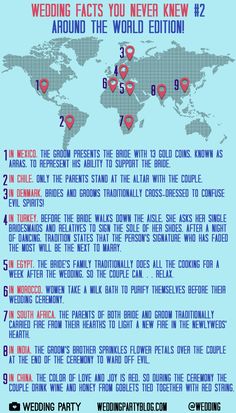Wedding is one of the most universal traditions in the world. But, it’s celebrated differently by everyone. Each culture has its own ways of making someone’s special day extra special. How can such a common ceremony be so different to everyone? Check out these traditions to find out.
Indian wedding celebrations last for days :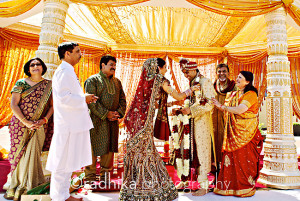
In India, weddings are surrounded by rituals and ceremonies. As part of the pre-wedding ceremonies, there is an Engagement Ceremony where the bride and groom exchange rings and the families exchange gifts and sweets. The Mehendi Ceremony is usually held at the bride’s home before the wedding ceremony and is the celebration when the bride’s palms, wrists, arms, legs, and feet are decorated.
On the big day, the bride and groom put flower garlands around each other’s necks in the Var Mala Ceremony to show the bride has accepted the groom as her husband.
Jewish wedding ceremonies are filled with symbolism :
In the Orthodox and Conservative Jewish faith, weddings cannot be held on the Sabbath or many other religious holidays. Rather than requesting “the honor of your presence,” as most invitations read, a Jewish wedding invitation will invite guests to “dance at” the ceremony.
And the invitation itself is two-sided, with one side written in Hebrew and the other in English. While standing under the Chuppa, a canopy meant to provide sanctuary from evil spirits, the groom stomps glass wrapped in cloth to symbolize the destruction of the Holy Temple in Jerusalem. It also symbolizes life’s mix of joy and sadness.
Japanese brides must physically show their devotion to their new in-laws :
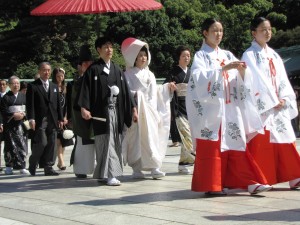
Japanese ceremonies were traditionally held in Shinto Shrines. The bride is painted pure white from head to toe, declaring she is a maiden. She also wears a white kimono and an elaborate head piece. During the ceremony, the bride wears a white hood to hide her “horns of jealousy” that she feels toward her mother-in-law and to display her resolve to become a gentle, obedient wife. To symbolize their union, the couple drinks sake together, becoming husband and wife once they take the first sip.
Brides have quite a few costume changes during the reception, first changing into a red kimono and then later into a Western-style dress.
Jamaican ceremonies often take a village to execute :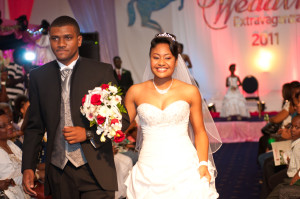
Jamaican weddings are a community affair, with the entire village often coming together to help plan the big day. Everyone in the village also gathers in the street to see the bridge and if she isn’t in tip-top shape, she is publicly criticized. And while women wear the typical white wedding dress, men wear a bush jacket for the event.
Several cakes are baked for the ceremony and on the wedding day, married women wearing white dresses carry the confections to the wedding. The reception is often held at the groom’s house, in a booth specially constructed for the event and made of coconut boughs and flowers. The wedding celebration also includes an abundance of dancing, including the Quadrille, typically a ballroom dance that slaves copied from their masters.
Islamic ceremonies are simple and structured :
The traditional nikah, or marriage ritual, is simple. However, many Muslims also hold multi-day celebrations in honor of the wedding. The bride and groom are separated at the wedding and can only see each other if their families allow.
The officiant goes to each room and asks the man and woman separately if they take each other in marriage. A marriage contract is then signed in front of witnesses. Once the contract is signed, the couple is brought together and declared man and wife.
During the process, the bride often wears a bright red ghagra, a pleated skirt with a blouse embroidered in gold, and men typically wear a sherwani with a turban. Before the main ceremony, wedding celebrations often kick off with a dholki, where women often gather at the bride’s house to sing and dance. Men sometimes take part too.
Even single relatives get the spotlight on a Cajun wedding day :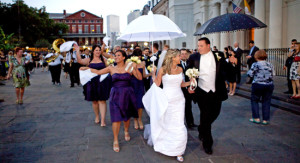
The Cajun people developed interesting traditions to compensate for the fact they were often isolated from the rest of the world. Since it could take weeks for a religious official to visit an area, betrothed Cajun couples would ceremoniously jump over a broom, signifying their marriage.
The broom has continued to play an important role in Cajun wedding ceremonies. Older unmarried siblings of both the bride and groom dance with a broom at the reception, mocking their single state. Instead of a picture, watch this older sister rocking it out with a broom.
Orthodox Russian couples live like royalty on their big day :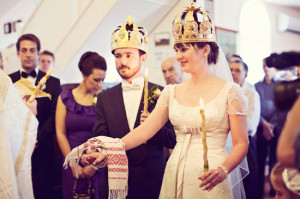
In Russia, only civil ceremonies are considered official. Couples hoping to have a religious ceremony must also have a civil one. They apply to the Department of Registration of Civil Statuses to be allowed to have a wedding. Once the application is complete, couples must wait one month before the actual ceremony.
In those religious ceremonies, if the bride and groom are a traditional Orthodox couple, they are crowned as royalty for the day. They stand on a special carpet to recite their vows, but before doing so, the couple races to the carpet. The winner is often considered the head of the household.
Malaysian ceremonies focus on the children the couple will produce :
As with many cultures, the couple’s future children are prominently displayed. In Malaysia, a groom might send his future bride child-bearing presents, such as trays of food with origami flowers and cranes made from currency bills.
The ceremony itself incorporates Hindu traditions in that the bride and groom sit in state while dressed in brocades and feed each other yellow rice with hands painted with henna. At the ceremony, each guest might receive an artistically decorated hard-boiled egg to symbolize fertility.
American ceremonies have combined some traditions from everyone else :
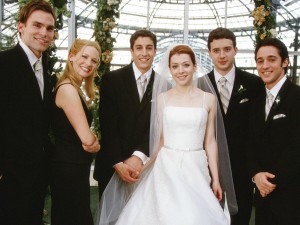
Many of the United States’ wedding traditions have been adopted from other cultures. Ceremonies in the United States are among the most flexible in the world. While most aspects of an American ceremony are adopted from European traditions or follow the couple’s unique culture, there are some traditions all ceremonies share.
A majority of American weddings include the wedding toast and the groom removing the bride’s garter to toss to the single men in the audience. The wedding kiss is also an important feature of weddings in the United States.
Chinese brides are shielded from their future husbands until the ceremony :
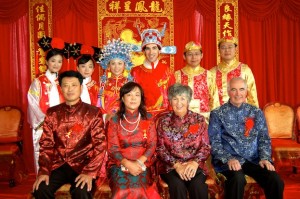
In Chinese tradition, a middleman was used to cement the rather lengthy engagement. The parents of the prospective couple controlled the negotiations. Once a man found a woman he wanted to marry, the go-between would present gifts to the girl’s parents.
The go-between would also be responsible for ascertaining the girl’s date and hour of birth. Both families would then review the auspicious nature of the match, including the bride and groom’s birth dates and hours, as well as consult an astrological expert. At the time of the actual ceremony, the bride was carried to the groom’s home in a covered sedan chair.
Current Chinese wedding ceremonies also place a heavy importance on auspicious dates. Fortune tellers consult Chinese almanacs and analyzes the prospective union. The bride and groom do not consult the almanac themselves, it is the job of a fortune teller.
Welsh weddings begin with a wooden spoon :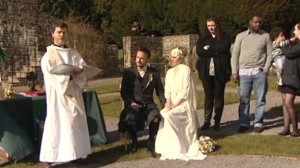
Spooning might not mean what you think. In Welsh wedding tradition, a man carved a spoon out of wood and gave it to the woman he loved. If she wore it, they were engaged.
Brides are often kidnapped by their families just before their wedding day in Wales. The groom and his family follow and whoever rescues her will be the next to get married.
In her bouquet, a Welsh bride carries myrtle, a symbol of love, and gives a cutting of the plant to her bridesmaids as well. If the bridesmaid plants the cutting in her yard and it blooms, she will soon marry, according to Welsh tradition.
Czechoslovakian ceremonies emphasize a couple’s future plans :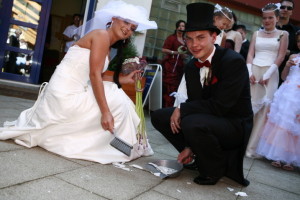
Before the wedding, the bride’s friends traditionally plant a tree in her yard and decorate it with colored ribbons and painted eggshells, because, according to legend, the bride will live as long as the tree.
Reproduction plays a central role in the Czechoslovakian wedding ceremony. Before the marriage vows, a baby is placed in the couple’s bed, to bless their fertility. The bride is also given three motherhood-promoting dishes: wheat for fertility, millet mixed with ashes that she must sort through in order to prove her patience, and in the third a sparrow hides under the lid.
During the wedding ceremony, Czech woman surround the bride, dancing and singing. They then remove her veil and put on a handmade babushka.
Traditional Norwegian wedding cakes are made with bread and cheese :
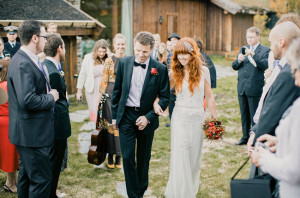
Fashion at a Norwegian wedding isn’t just for aesthetic affect. The bride will traditionally wear a white or silver wedding gown as well as a silver or solver and gold crown.
Small spoon-shaped bangles that tinkle when moved also hang from the crown. According to Norwegian legend, the music produced from these bangles will ward off evil spirits. The groom wears a traditional hand-made woolen suit known as a bundas.
The wedding cake, also know as kransekake, at a Norwegian wedding isn’t a traditional cake. It is made of bread and topped with a mixture of cheese, cream and syrup. The dessert is then folded over and cut into small squares.
In Germany, families plan ahead for the financial burden of a wedding :
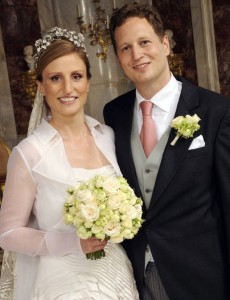
German wedding traditions begin at birth. When a little girl is born in Germany, several trees are planted in her honor. These trees are then sold once her wedding date is set, the idea being that the money from the sale will be used for her dowry.
Friends and family of the couple also create a wedding newspaper, which is filled with pictures, articles and stories of the engaged couple. The proceeds from the newspaper, which is sold at the wedding, help pay for the honeymoon.
The marriage ceremony is actually done in three parts. First there is the day when couples have a civil ceremony at city hall. The next night is the party. At the party, many friends and neighbors bring old dishes to break, believing it to be good luck. The third day is the religious ceremony. The flower girl, the bride’s only attendant, walks in front of the bride and sprinkles petals on the floor to wish the couple good luck.
The wedding dress dominates a Cuban wedding :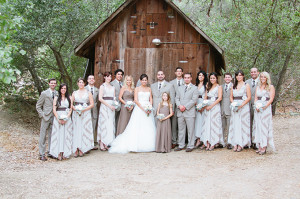
Due to Communist rule, the ceremony can’t be a religious event. People still find a way to celebrate though. Often, a parade of guests and family members takes place on the way to wedding venue, bringing music and dancing with them.
As far as the dress goes, the most important element by the way, “the more extravagant the dress is the better,” says Havana-Guide.com. The dress is often made of silk or satin and includes full skirts and ruffles. Since the ceremony can get a little costly, wedding guests conduct a money dance at the ceremony. During the dance, every man who dances with the bride pins money to her dress to help the couple pay for their honeymoon.
Reference — http://www.businessinsider.com/how-weddings-are-celebrated-around-the-world-2011-10?IR=T

